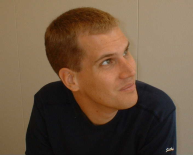Amina Chip - a miniaturized measurement system for ambient ammonia
Promotion date: 28 May 2004
| About 15 years ago ECN developed an ammonia monitor, a device to measure ammonia in the air. This was partly commissioned by RIVM (Rijks Instituut voor Volksgezondheid en Milieu) who set up a national programme to ‘sniff’ ammonia in the air, the reason being the intensive cattle breeding and the numbers of live stock in the Netherlands. The Netherlands and Belgium have the highest ammonia emission in Europe, the areas of intensive cattle breeding show clearly on emission maps. |
What is your thesis about?
About 15 years ago ECN developed an ammonia monitor, a device to measure ammonia in the air. This was partly commissioned by RIVM (Rijks Instituut voor Volksgezondheid en Milieu) who set up a national programme to ‘sniff’ ammonia in the air, the reason being the intensive cattle breeding and the numbers of live stock in the Netherlands. The Netherlands and Belgium have the highest ammonia emission in Europe, the areas of intensive cattle breeding show clearly on emission maps. Normal ammonia levels in the Netherlands are about 5 ppb (five ammonia particles on a billion air particles), whereas in countries without our number of cattle, concentrations remain below 1 ppb. To get our high ammonia concentrations down, a very precise monitoring device is needed that measures ammonia in the air without interference from other gaseous compounds. The device that was developed is rather big, it works very well but requires a lot of maintenance and uses a lot of gas (1 l per minute for 20 minutes, a total of 20 l). So the challenge was to develop a smaller device, which also could be used to diagnose peptic ulcers on the breath of patients. MESA+, of course, is specialized on devices on micro- and nanoscale, so we were asked to develop this application.
Did you have to change the original working principle of the ECN device?
No, the principle is identical, working with a membrane which is water repellent but permeable for gas molecules and ultimately transforming the gaseous ammonia into measurable ammonium ions. We did have to put quite a bit of research into the detectors, to meet the demands of size. Along the way we optimized the device as well and did some modelling.
And does it work?
Yes. And it measures 2,4 cm x 4 cm x 2 mm, so smaller than a credit card. But this is only the detection part of the machine, without the pumps. It can measure down to 1.3 ppb in only a few hundred ml of air, a reduction in gas consumption by a factor of 20. The selectivity towards interfering gasses like CO2 seems sufficient for the device to be used as a diagnostic breath analyzer.
This is more like a very specific engineering job?
Yes, it is. That is an aspect I like about application research, you know that what you are doing has a very particular and specific use. Now, a prototype for breath analysis will be developed, which, if all goes well, will be at the disposal of every GP in about ten years enabling the diagnosis of various diseases. And besides, the research was not that specific, there was a lot of new research to be done.
Has there been a moment that the solution you thought would work proved inadequate so that you had to think of something else?
Yes, I have had to think of another solution for the membranes between the two channels, they proved to be the biggest challenge having to be porous on the one hand and stopping the ions on the other. We could not use the original Teflon® membranes ECN used in their macro-scale device. We tried micromachined Si3N4 membranes made in our MESA+ clean room and it would have been the perfect solution if technologically possible. There was no chance we could integrate these membranes in our system so we had to look for another membrane type, which is a shame because I have to glue the membranes on the chip by hand.
Are you going to register a patent?
It is thought of but not decided yet. We can’t register a patent for the device itself since it already exists but we are looking into the other application: the detection of peptic ulcers using breath ammonia analysis.
Your research involves a lot of chemistry, did you miss a chemical background?
The chemistry involved is not too difficult. What I really needed to catch up on was membrane technology, but also on some chemistry. My background is electro-technical engineering.
What are you going to do now?
I will start a new job as from August 1 as a Design Engineer at Texas Instruments in Almelo, sniffing gases again.
For the summary of the thesis, click here.

